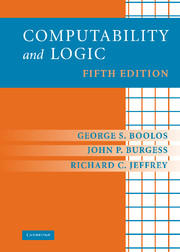Book contents
- Frontmatter
- Contents
- Preface to the Fifth Edition
- COMPUTABILITY THEORY
- BASIC METALOGIC
- FURTHER TOPICS
- 19 Normal Forms
- 20 The Craig Interpolation Theorem
- 21 Monadic and Dyadic Logic
- 22 Second-Order Logic
- 23 Arithmetical Definability
- 24 Decidability of Arithmetic without Multiplication
- 25 Nonstandard Models
- 26 Ramsey's Theorem
- 27 Modal Logic and Provability
- Annotated Bibliography
- Index
25 - Nonstandard Models
Published online by Cambridge University Press: 05 June 2012
- Frontmatter
- Contents
- Preface to the Fifth Edition
- COMPUTABILITY THEORY
- BASIC METALOGIC
- FURTHER TOPICS
- 19 Normal Forms
- 20 The Craig Interpolation Theorem
- 21 Monadic and Dyadic Logic
- 22 Second-Order Logic
- 23 Arithmetical Definability
- 24 Decidability of Arithmetic without Multiplication
- 25 Nonstandard Models
- 26 Ramsey's Theorem
- 27 Modal Logic and Provability
- Annotated Bibliography
- Index
Summary
By a model of (true) arithmetic is meant any model of the set of all sentences of the language L of arithmetic that are true in the standard interpretation N. By a nonstandard model is meant one that is not isomorphic to N. The proof of the existence of an (enumerable) nonstandard model of arithmetic is as an easy application of the compactness theorem (and the Löwenheim–Skolem theorem). Every enumerable nonstandard model is isomorphic to a nonstandard model M whose domain is the same as that of N, namely, the set of natural numbers; though of course such an M cannot assign the same denotations as N to the nonlogical symbols of L. In section 25.1 we analyze the structure of the order relation in such a nonstandard model. A consequence of this analysis is that, though the order relation cannot be the standard one, it at least can be a recursive relation. By contrast, Tennenbaum's theorem tells us that it cannot happen that the addition and multiplication relations are recursive. This theorem and related results will be taken up in section 25.2. Section 25.3 is a sort of appendix (independent of the other sections, but alluding to results from several earlier chapters) concerning nonstandard models of an expansion of arithmetic called analysis.
Order in Nonstandard Models
Let M be a model of (true) arithmetic not isomorphic to the standard model N.
- Type
- Chapter
- Information
- Computability and Logic , pp. 302 - 318Publisher: Cambridge University PressPrint publication year: 2007



